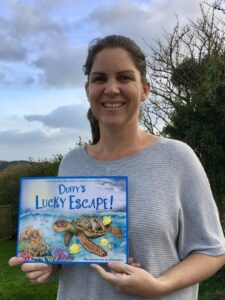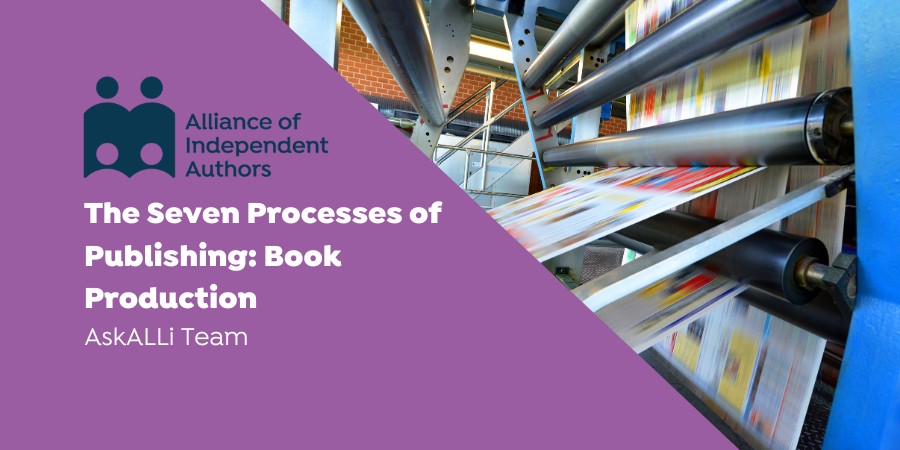Welcome back to the seven processes of publishing series, where the Alliance of Independent Authors AskALLi team is breaking the craft of publishing down into its seven constituent processes and advising authors on best practice for each. Today, we're advising on the book production process.
An overview of the seven processes can be found in this post. The rest of the processes can be found here:
What is Book Production?
Before digital publishing, producing a book meant assembling physical covers and pages. The core format was print and book production required an interior designer and typesetter to arrange and format text to be visually pleasing and well balanced and set up the jacket (cover) in paperback or hardback to put the book together.
Today, indie authors use digital tools to produce books in three formats: ebook, print and audiobook and for most indie authors the core format is ebook because it is easiest, cheapest, and quickest to produce.
Software has reduced the need for interior designers, but if you have complex needs, such as illustrations, graphics or charts, you’ll still need to work with a formatter. But do check your tech options, especially if you’re writing a text-only book like a novel. You can read our ultimate guide to print formatting here.
How much time you spend on production depends on how creative you want to get. You can express your creativity with font choices, page design, illustrations—and there’s plenty of room for that too.
ALLi Director, Orna Ross says:
“I’m pretty practical about production, most of the time. I write on Scrivener and design using Vellum, a software program for Mac. These two softwares are sufficient for all my production needs for my standard books. I mostly keep my creativity for the writing rather than the production. Every so often, though, I like to do something that’s more complex and needs other human hands.
In 2015, I produced Secret Rose, a special hardback gift book for a WB Yeats anniversary in replica of his 1890s original. More recently, I worked with a young artist, Miki Lowe, and designer, Jane Dixon-Smith, to make the series of creative business workbooks and planners that accompany my Creative Self-Publishing book. And I’m about to start work on a premium gift edition poetry book with AI illustrations.”
Which Format First?
If this is your first time publishing (and if you are not using Vellum, which produces electronic and print formats simultaneously), start with an ebook, as that will set you up fastest for sales. Once you’ve mastered ebook production, and sold some books, you’ll have much of the materials and skills you need to produce print and audio, which are more time-consuming and expensive.
The sales process across the three formats is similar, so once you’ve proven to yourself that you can make and sell ebooks, reinvest some of your profits into making a print and audiobook edition as soon as you can afford to. This also gives you a chance to make sure you have fixed any errors that may have found their way into the ebook, before committing to these more permanent formats.
Although with print-on-demand, also known as POD, it’s possible to make changes after publication, it is more complex to mark corrections, and even more so with audio.
The assumption here is that you are like most indie authors, and most of your income will be generated by online sales of ebooks and audiobooks on your own website and on platforms such as Amazon or Apple. However, there are other models for distribution and sales and you may have quite different plans, in which case, of course, you will be guided by your needs.
We all have our preferred reading format. Many older authors, in particular, are romantic about print. They love the feel, the smell, and the weight of a print book in their hands. But a good publisher knows that this personal preference is irrelevant. The job is to get books into as many formats as possible so that readers can have their own preferred format, not ours.
And, from our point of view as publishers, each format also serves as a discovery tool for our other formats.
ALLi, therefore, recommends that you publish in as many formats as you can. Obviously, this will be time and money dependent, but having many formats is the ultimate goal.
Ebook Production for Indie Authors
When producing an ebook there are two types of layouts to choose from, fixed or reflowable. A fixed-layout ebook acts more like a print book, but a reflowable layout allows the reader a lot more control over how they view the file.
The key point to keep in mind is that reflowable text in an ebook behaves differently to a print book. There are natural expectations that come with reading print books, like rarely hyphenated words and a linear reading experience that are not replicated in most ebooks.
- Some of the common features that are alterable on an e-reader or app are:
- font style (changing the type to a serif or sans serif font)
- text size (this can create a lot of hyphenated words)
- reading orientation (portrait or landscape)
- leading (the space between the lines of text)
- margins
- justification (whether or not to space words to fit columns)
- page-turn or scrolling
- theme (white, sepia, night-mode, etc.)
- auto-hyphenation
- single-page or two-page view
The availability of the above options depends on the device or app. Your esthetic intentions may or may not be maintained once the reader has their hands on your reflowable ebook.
Many writers prepare their work in Microsoft Word or Mac Pages and then have it converted into one of the publishing formats welcomed by the major ebook publishers. This process is called formatting. You can read more about publishing ebooks in our guide here.
It may be very simple if your book is straightforward prose like a novel, or more complex if you have illustrations, charts or other specialized layout needs. You may also wish to add design flourishes such as drop capitals at the start of a chapter.
Authors have a wealth of options for creating ebooks. Smashwords, one of the earliest distributors of ebooks, once made a list of the various book-creation tools authors use, and it included a wide variety: Adobe InDesign®, Apache OpenOffice, Atlantis, Calibre, ePubMaker at Project Gutenberg, HTML, Jutoh, LibreOffice, Nisus Writer Pro, Scrivener, Sigil, Writer2ePub, and more. The two big favourites in the indie author sector are Vellum (for Mac Users) and Atticus.
Each produces good results, so the choice is down to personal use and preference.
ebook Formats
We speak of ebooks as a single format but there are actually several. Here, in alphabetical order, are those most commonly used at present.
The two most important are those used for distribution: EPUB and KPF (Kindle Package Format) for the Kindle. While retailers like Apple, Barnes & Noble, Kobo and others use EPUB for distribution, the Kindle file is Amazon’s proprietary ebook format. It’s exclusively sold through Amazon and can only be viewed on Kindle devices or the Kindle app.
EPUB
EPUB (short for “electronic publication”) is now the most widely used ebook format, and the industry standard, supported across all platforms. All e-readers—Apple iOS, Barnes & Noble’s Nook, Adobe Digital Editions, Kindle, Aldiko on Android and nearly 300 others—support EPUB files (suffix .EPUB).
The EPUB format is “open standard.” That means it is free and publicly available. There are specific rules for its usage maintained by a global trade and standards organization, W3.org. The EPUB format has been through three iterations and all agree that EPUB 3 is a major advance for illustrated and complex books.
EPUB was built from the intersection of internet technologies and print books. Books made special demands that didn’t apply to web pages. We expect to be able to read ebooks while offline, to be able to save them, keep them and share them, and to be able to buy and sell them. Books, even in electronic format, offer a kind of permanence we don’t typically expect of websites.
The Book Industry Study Group endorses EPUB 3 as the format of choice for ebooks and is encouraging the global publishing industry to adopt and promote this single standard. ALLi supports this call and encourages it as the preferred option for indie authors. EPUB documents take the extension .epub.
Kindle
Kindle File Format is a proprietary ebook file format created by Amazon that can be downloaded and read on devices like smartphones, tablets, computers, or e-readers that have Amazon's Kindle app. Kindle documents generally take the extension .azw
Mobi
The Mobipocket ebook format is now being retired. It was another cross-platform, open standard format, and was best known as the favored format for Amazon’s KDP (Kindle Direct Publishing). Mobi documents took the .mobi extension
Print Book Production for Authors
The majority of readers still read in print, sometimes in addition to digital alternatives like ebook and audio, sometimes exclusively.
Although print books typically yield a much smaller profit margin than ebooks, publishing in print enables you to grow your fanbase and, if you get your pricing right, your income. Print-on-demand makes that relatively easy and affordable for you, when selling online, though the cover price will be higher than the price of a trade-published book, which uses print runs and, if they are one of the Big 5, economies of scale.
Although print books typically yield a much smaller margin than ebooks, publishing in print enables you to satisfy readers who prefer that format, and thereby grow your fanbase and income. Print-on-demand makes that relatively easy and affordable for you, though your reader will pay more for a POD book published by a micro-publisher (you!) than they would for a corporately-published book in the bookstore.
The layout of the inner pages is an important aspect of book design. Your cover designer might be able to do this for you, or you can hire another service, or you can use one of the software options to generate the files you need, like Vellum (Mac only, limited design options) or Scrivener (more complex, but more flexible). Template page designs, which are available on most self-publishing platforms, can also be used if you do not mind the effort involved and the cookie-cutter designs.
Your layout is exported as a PDF, which is then uploaded by the printer or self-publishing service.
Once you have your PDF, there are two ways that books can be printed: print-on-demand or a print run.
Print-on-Demand (POD)
Print-on-demand was introduced in the 1990s and ignited the era of Self-Publishing 1.0. It allows authors, and other publishers, to produce a single copy, or a short print run (say, ten, twenty or fifty), instead of hundreds. I've always thought the process should be called “print-on-request”, but it’s too late now.
There are two large print-on-demand distributors for authors: KDP Print (formerly CreateSpace) and IngramSpark (formerly Lightning Source). But many others are coming to the front of the market such as BookVault and Lulu. With print-on-demand, when a reader orders a copy of your book from the sales outlets serviced by either of them (Amazon’s worldwide stores for KDP Print, and brick-and-mortar bookstores and libraries for IngramSpark), the order is sent to a printer which prints and assembles your book there and then, and ships it directly to the reader. This “just-in-time” production system saves us from having to:
- Keep expensive inventory.
- Store stock against future orders.
- Fulfil orders as they come in.
The platform funds the production, bills the customer, takes their cut for production and distribution, and then pays you the rest as publisher’s compensation (often wrongly called “royalties”).
Some authors believe IngramSpark offers better quality, others prefer KDP Print and more recently BookVault is rapidly becoming the new preference. Opinions can be quite heated. Having surveyed thousands of titles over the years, our conclusions is that the interior print quality of black-and-white books is similar between the two services.
It’s also worth noting that the quality of print-on-demand books is improving all the time.
Interior Options
One key decision you have to make, regardless of which service you use, is trim size. This describes the dimensions of the book, such as 6 x 9 inches or 5.5 x 8.5 inches. Both KDP Print and IngramSpark offer all the industry-standard trim sizes, and some variations. We recommend you stick to standard trim sizes, unless you have a very good reason to do otherwise. The standard sizes are easier to work with across the platforms and give you more choices with distribution channels.
For non-fiction and business books, 6 x 9 inches is the most common size, and for fiction and poetry the usual size is 5.5 x 8.5 inches. A bigger trim size gives you bigger pages, obviously, so your book will be slimmer—another factor to bear in mind. A slimmer book costs you less to print, but if your book is less than 40,000 words, 6 x 9 inches can feel unsubstantial. If you’re working with a designer, they can advise you on the optimum size.
Both KDP and IngramSpark offer black-and-white and color interiors. Color print-on-demand is usually two or three times more expensive than black-and-white, even if you haven’t used color on very many pages, so think carefully about whether color is essential in your book. Of course, it is for many—children’s picture books, for example, or premium gift books.
When you choose black-and-white printing, you also get a choice of paper: bright white, cream/off-white or groundwood. Cream paper is generally slightly thicker, and paper thickness can change the spine calculations for your cover, so decide your choice of paper before creating your cover. White paper can look odd for fiction and narrative non-fiction.
Consignment Print Run
Before print-on-demand became cheaply available, a print run was the only option for publishers, and many still use it because it’s cheaper per book. The minimum order for a print run used to be 250, ideally 500 to make it worthwhile. Now printers will provide as few as 50 books, at reasonable cost.
The bigger the print run, the lower the unit price, but only once all the books are sold. A thousand books for $2,000 gives you a book that costs $2 when you’ve sold every copy. If you sell only a few, you’ve paid hundreds of dollars per copy sold. Print runs are, therefore, riskier than POD and before ordering a print run you should have a solid marketing and distribution plan in place e.g. an agreed special sales deal, or a regular speaking gig where books are sold at the back of the room.
Every week at ALLi, we hear of self-publishers who’ve spent thousands of dollars to print books that languish in their garage, to eventually be sent to the landfill.
Audiobook Production for Indie Authors
Read more about self-publishing audiobooks here.
Audiobook production is the process by which your written book is narrated and recorded. The market for audiobooks is growing steadily. The first heavy consumers of audio were only older females and those with impaired vision or difficulty reading, but now there is a growing young audience who listen on their phones and other devices. And, of course, listening in the car is huge. In the UK, audiobook sales increased by 38% in 2018 and some time-strapped people now “read” only in audio.
For some indie authors, audio is now the second format of choice. They produce ebooks first, then audio, then print. Audio is less well established than print or ebooks, so there is less competition in this sector. Genres that are particularly popular in audio, like business books, may even benefit from being produced in audio first.
The process of making an audiobook is more complex, expensive and demanding than producing a print book or ebook, so most authors wait until they have a clear marketing plan and already know how to sell books.
Amazon, again, is a huge player in the production of audiobooks. According to IBISWorld, Amazon’s Audible controls over one-third of the audiobook market. Compare this to 5.1% for Penguin Random House, for example, or 3.9% for HarperCollins.
ACX.com is Amazon Audible’s marketplace and self-publishing platform, “where authors, literary agents, publishers, and other rights holders can connect with narrators, engineers, recording studios, and other producers capable of producing a finished audiobook,” and is a tool wide open to authors.
You can choose from two royalty models: payment upfront, or what they call “royalty share”, though strictly speaking these are commissions, not royalties, where narrators get a percentage of each sale.
ACX offers exclusive and non-exclusive options, with different royalty rates, and, as ever, ALLi recommends that if you want to maximize your income over the long term, you should definitely work with Amazon, yes, but on a non-exclusive basis.
Audible promises authors 40% commission on each book sold, but this is 40% of what’s left after the retailer has taken their share. Tim McConnehey, founder and owner of collaborative publisher, Izzard Ink Publishing, laid out the economics on the ALLi blog, based on having an exclusive agreement with ACX on an audiobook that retails for $24.95.
Tim McConnehey, founder of IzzardInk
“Right from the top, the retailer gets $6.08, or about 24.37 percent. After that, $13.48 goes to ACX, or about 54.3 percent. Only $5.39, or 21.6 percent, goes back to the author. And in some cases, it can be even less than that… ACX also offers different compensation based on how each book was sold.
In our example, à la carte sales on Amazon or iTunes would pay $9.98 to the author, Audible sales to non-members would pay $6.98, and sales to Audible members would pay just $5.19. And there’s no way to predict what proportion of these will make up your overall sales.
Without an exclusive agreement with ACX that prevents you from selling your book elsewhere, you’ll make even less— $3.37 in our example.
Moreover, authors don’t decide the price of their book through ACX, which means it’s impossible to accurately calculate what kind of return you can expect. By leveraging their nearly exclusive control over the industry and distribution channels, Audible is effectively fixing prices.”
Tim McConnehey
Colleen Cross discusses whether or not you should sell your audiobook rights in this post. And looks in detail at how ACX split and distribute payments to authors here.
In recent years, other players have entered the audiobook market and are offering publishers and authors more control over product and revenue. Findaway Voices, recently taken over by Spotify, not only offers discounts and allows authors to set prices, but it pays authors a higher percentage from many retailers.
While ACX only sells through Amazon, Audible, and Apple, Findaway covers those retailers and dozens more, including Google, Scribd, Audiobooks.com, Walmart and Nook.
Check out ALLi’s Self-Publishing Services Directory for other good audiobook production and distribution options. We also recommend Audio for Authors by ALLi Enterprise Advisor, Joanna Penn, who has been, for a longtime, an audiobooks pioneer.
Narration
If you decide to make an audiobook, your first big decision is whether you are going to narrate the book yourself. It’s more common for authors to perform their own audiobook in non-fiction than in fiction. The various characters, dialog, voice ages, accents and modes of description require a professionally trained voice actor. Nothing is worse than the sound of an author who doesn’t understand voice projection, reading page after page of their own work, not realizing that they are deadening their own prose. Readers do like to hear the writer’s voice—but only if the writer does it well.
Doing it well also means a soundproofed place with good recording equipment and software. No, your phone earbuds are not good enough. The equipment and software are not expensive. By far the biggest investment is time—time to narrate your book and time to edit your files in post-production.
Audible estimates the average narrator reads 9,400 words per hour, so a 70,000-word novel would take approximately 7.5 finished hours. Budget about 2.5 times the length of the finished audiobook for total recording time needed, to allow for breaks and retakes.
After you’ve finished, you will need to listen to the entire book and fix or re-record parts. This process will likely take three to four times the length of the fully recorded audiobook. Then you need to prepare the files for upload.
So, for an audiobook of 70,000 words, you can budget an additional twenty to thirty hours of post-production work, but rates are not standard as different channels have different models of sales and subscription.
Many authors are now using AI narration for their audiobooks. This reduces costs considerably but many listeners report that the voices are still too machine-like, though they are improving all the time. It’s now even possible to have your AI voice double narrate your book. At time of writing, Audible and other major audiobook distributors do not accept AI narrated books.
Hiring a Narrator
Most authors choose to hire a professional narrator. To do so, create an account at one of the audiobook publishers or production companies, such as ACX or Findaway, and find a narrator (sometimes called a producer) by listening to their auditions. When you find someone you like, you agree how much they will get paid for each finished hour of the audiobook. They record and upload the audiobook, which you then approve.
Other Formats
In addition to the three core formats of ebook, print book and audiobook, your books can also generate translations, films, TV programs, merchandise and many other formats. These are traditionally called subsidiary rights and are given a separate section in a publishing contract.
ALLi Member Case Studies

Ellie Jackson
Children's Illustrated Book Production with Ellie Jackson
I produce all of my books through a very similar process – whether that is right or wrong I don’t know but it has worked successfully for the last 6 years so I am hesitant to change it!
I produce children’s picture books based on true environmental stories covering issues such as plastic pollution, climate change and habitat loss. After researching an issue and finding a suitable story and animal, I write my first draft and sketch out the illustrations that I would like. I then send these to my illustrator to turn my stick people version into beautiful watercolour artwork. After several months the illustrations are ready to be digitally worked on.
We use Adobe Indesign and Photoshop to ensure the illustrations are high print quality – this process of editing can take several weeks. Once the books have been digitally brought together in Indesign, after several edits and rewrites we make the story fit the illustrations, page length and paragraphs. Finally the book is ready to be sent to the printers.

Ellie Jackson, author
I never order proofs – I trust my printers as I have worked with them and built up a good relationship. The colours have very occasionally varied from the digital copy but this has not affected the overall quality or detracted from the book. My first print run I ordered 1250 books and now I only order in quantities of 5000. So far I have ordered over 120,000 books and sold over 80,000, so I hold a years supply of books in storage. I have found this is the only way to reduce costs to a point where I can compete competitively and offer the discounts that retailers and wholesalers are accustomed to.
I have only ever offered my books in paperback format although I often get asked about ebooks and hardback copies. This is something I would consider in the future if needed.
I wish I was organised enough to have the book formatted and ready for release far in advance but more than likely I am still making changes up to the day it is sent to the printers. I do preorder sales for my retailers a couple of months before the book is delivered. On delivery day I can have several tonnes of books to move and this can present quite a challenge! I like to get the books signed and posted out the day of or the day after delivery so it is a busy few days – mostly with several thousand pounds of orders heading out the door which is always a great reward for that hard work!
Ellie Jackson, is a children's author writing true stories about real environmental issues for children. Find out more about her on her website: www.wildtribeheroes.com

RJ Blain, Romance Author
RJ Blain On her Production Process
The AskALLi team spoke to RJ all about her production process.
Q.How do you produce your books?
I write my books in Scrivener (Mac edition), review my editor's notes in Microsoft Word, and do my personal proofing runs in Microsoft Word along with a mix of programs, from reading apps to printed paper to finalize the book, including Vellum, which is my formatting software.
Q. What do you use to format?
I use Vellum. It consistently (and reliably) produces professional-level outputs in numerous trim sizes and greatly simplifies the final production process.
Q. Do you consider yourself an ebook first, paperback first or audio first author, and why?
I produce e-books first. If I have sufficient lead time or I am aiming for specific sales goals, I will release print at the same time as e-books. I generally do not hold an e-book back for print or audiobook formats; the production process on these simply takes too long, and my narrator(s) are often booked 4-6 months out.
Q. Do you order proofs and/or do short print runs? And do you release all formats at the same time?
Usually, I will order proofs, but I have had sufficient practice at the print production process (and a skilled designer who rarely makes mistakes on that front) to release the print edition without the proof. There has only been one or two times over the course of 60+ books released that I regretted this decision, and it was a quick fix to rectify each time.
Q. How far in advance do you have a book formatted and ready for release?
I prefer being locked and loaded at least 3-4 weeks prior to my release date, but life sometimes happens. Running the wire (turning the book in shortly before its lock date) is highly stressful, but I have needed to do it from time to time. Currently, I aim for 3-4 weeks to make certain I have time to address any potential issues with the book.
If I am attempting a bestseller list run (although this is no longer the case due to the fall of the USA Today list), I would try to have 4-6 weeks of lead time to make certain the print edition is ready on time.
R.J Blain writes paranormal romance and urban fantasy with a comedic twist. Find out more about them on their website.






This post definitely resonates with me as an aspiring indie author! The breakdown of pre-digital vs. digital production is super helpful, and knowing ebooks are the “easiest, cheapest, quickest” is music to my ears (budgeting author struggles are real!).